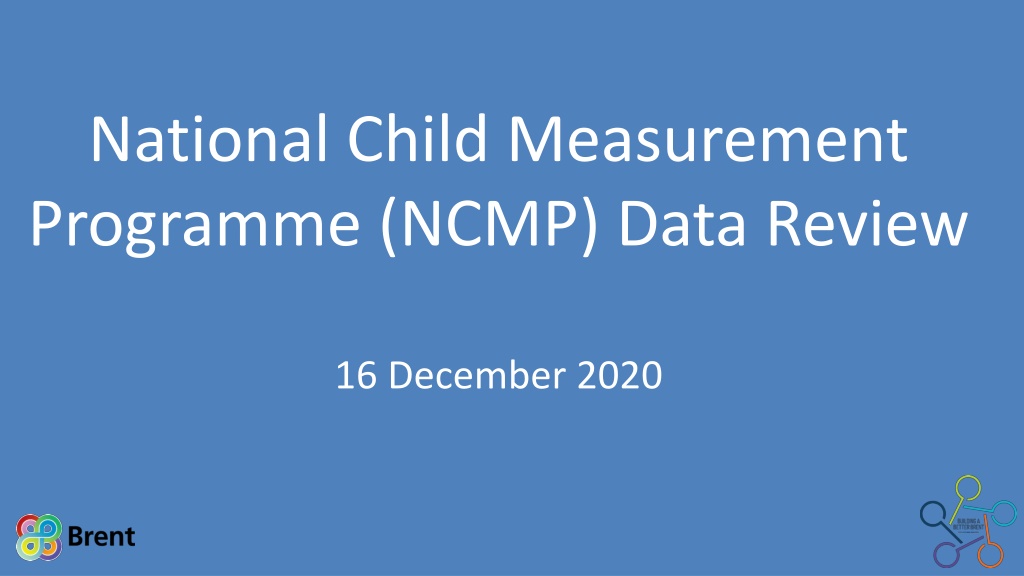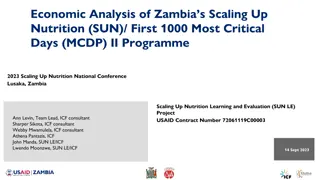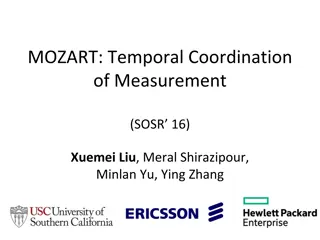National Child Measurement Programme (NCMP) Data Review
The National Child Measurement Programme (NCMP) in England measures the height and weight of over a million children aged 4-5 and 10-11 each year. This review focuses on NCMP data sets from 2017/18 to 2019/20 for Borough of Brent. The analysis includes BMI trends, gender distribution, and ethnicity summaries. The study aims to understand child obesity trends and resource allocation needs based on school and ward details.
Download Presentation

Please find below an Image/Link to download the presentation.
The content on the website is provided AS IS for your information and personal use only. It may not be sold, licensed, or shared on other websites without obtaining consent from the author.If you encounter any issues during the download, it is possible that the publisher has removed the file from their server.
You are allowed to download the files provided on this website for personal or commercial use, subject to the condition that they are used lawfully. All files are the property of their respective owners.
The content on the website is provided AS IS for your information and personal use only. It may not be sold, licensed, or shared on other websites without obtaining consent from the author.
E N D
Presentation Transcript
National Child Measurement Programme (NCMP) Data Review 16 December 2020
NCMP Introduction The National Child Measurement Programme (NCMP) is a nationally mandated public health programme. NCMP measures the height and weight of over one- million children aged 4-5 and 10-11 years each year in primary schools in England NCMP is a key part of the government s approach to tackling child obesity. The NCMP dataset also includes deprivation data Public Health England provides strategic leadership and support for this programme, and local authorities deliver it. https://www.gov.uk/government/collections/nation al-child-measurement-programme
NCMP Data The Data 2 key data sets under review in this study NCMP 2017/18 = 7327 rows NCMP 2018/19 = 7336 rows NCMP 2019/20 = 7160 rows Data for Borough of Brent only Key fields Included in NCMP data: Gender Ethnicity summary Ethnicity detail BMI score BMI code School data School ward data Method & Analysis Using SPSS software, this is statistical analysis software which is especially useful for running the correlation elements of the project. Interim presentation to focus on BMI, School data and Ward data.
Objectives Key Objectives: Review BMI trends over the period Ensure detail by ward is included Ensure that school detail is included in order to understand where resources need to be allocated. Sections in Presentation Categorical Data BMI Data Conclusions Appendix
NCMP Gender Relatively even split between males and females in the sample. Gender is an important categorical variable when considering BMI data. 2019/20 gender data has same % split as previous year. Gender % 120 100 80 50.7 50.7 Percentage % 51.6 60 40 49.3 49.3 48.4 20 0 2017/18 2018/19 2019/20 Female Male
NCMP Ethnicity Summary Ethnicity summary Data quality issue as the not stated in 2018/19 is large (16.1% of population) versus only 3.2% in the previous year. This dropped to 10% in 2019/20, but remains high. This figure has not been adjusted as NCMP is official data and also any adjustment could equally be open to criticism. Ethnicity Summary % 35 30 28 24 25 Percentage % 19 20 15 11 10 10 7 5 0 0 Asian Ethnicity Black Ethnicity White Ethnicity Chinese Ethnicity Mixed Ethnicity Other Ethnicity Not Stated 2017/18 2018/19 2019/20
NCMP Ethnicity Detail Ethnicity detail The not stated causes similar issues relating to comparison despite improvement The schools to potentially contact to improve data collection are listed in appendix 1 The top 10 schools listed in appendix 1 account for 68% of this not stated segment It is recommended that a data improvement initiative is implemented. Perhaps as simple as writing to each school. Ethnicity Detail % 20 18 16 14 Percentage % 12 10 8 6 4 2 0 Ethnicity Detail 2017/18 Ethnicity Detail 2018/19 Ethnicity Detail 2019/20
NCMP Reception & Year 6 % split between reception and year 6 This is an important categorical characteristic when considering BMI Gradual increase in year 6 percentage over the 3 year period Reception & Year 6 60 51.2 50.8 50.7 49.3 49.2 48.8 50 40 Percentage % 30 20 10 0 Reception Year 6 2017/18 2018/19 2019/20
BMI Definitions BMI is classified according to the following image using the British 1990 growth reference (UK90) The NCMP data set follows the classification The term very overweight is used rather than obese in the NCMP data
Body Mass Index Reference Curves for the UK, 1990 (Cole, Freeman & Preece) BMI of children is more complex than for adults Children s BMI changes as they mature and growth patterns differ between boys and girls. Therefore both the age and gender of a child need to be taken into account when estimating whether BMI is too high or too low. These thresholds are derived from a reference population, known as a child growth reference. They are calculated by weighing and measuring a large sample of children to identify how BMI varies by age and sex across the population. The UK90 BMI reference provides centile curves for BMI for British children from birth to 23 years. This is based on a sample of 32,222 measurements from 12 distinct surveys collected between 1978 and 1994. The UK90 shows the pattern of growth and also provides an average BMI for a boy or girl at a particular age, and the distribution of measurements above and below this value. This means that individual children can be compared to the reference population and the degree of variation from an expected value can be calculated.
Brent BMI Classification 31% Overweight or Very Overweight, Improvement Continues ! The improvements seen in 2018/19 continue into 2019/20 Increase in healthy weight by 2.7% to 66.5% Overweight % continues to fall to 12.7% in 2019/20 (1.6% decline versus previous year). Similarly the very overweight (obese) % fall to 18.3% In 2019/20 there were 31% in the overweight and very overweight categories (against 33.8% in 2018/19) The initiatives in place are working BMI Code 70 66.5 63.8 61.4 60 50 Percentage % 40 30 21.5 19.5 18.3 20 15.3 14.3 12.7 10 2.5 2.3 1.8 0 Underweight Healthy Weight Overweight Very Overweight 2017/18 2018/19 2019/20
Brent BMI Classification 2.2k Pupils Overweight or Very Overweight But Improvement 1287 pupils very overweight (obese) and 889 overweight = 2176 in 2019/20 combined Improvement on previous years 2453 in 2018/19, so absolute numbers have reduced by 277 pupils in 12 month period. BMI Code 5000 4664 4622 4425 4500 4000 3500 3000 Number 2500 2000 1547 1414 1287 1500 1102 1039 889 1000 500 177 168 128 0 Underweight Healthy Weight Overweight Very Overweight 2017/18 2018/19 2019/20
% Overweight & Very Overweight Increases In The Year 6 Cohort By school year there is a large increase in very over weight in year 6 compared to reception year (graph illustrates point). The over weight and very overweight averages have declined progressively from 36.8 in 2017/18 to 33.8% in 2018/19 and down to 31% in 2019/20 There are 37 schools where BMI is greater than the 31% average (2019/20) for the overweight and very overweight categories (these are graphed on slide 20) The full listing (all 63 schools) is included in appendix 2, also see appendix 3. School Year Comparison 25.2 Very Overweight 2019 26.0 Very Overweight 2018 28.1 Very Overweight 2017 Overweight 2019 Overweight 2018 Overweight 2017 Healthy Weight 2019 Healthy Weight 2018 Healthy Weight 2017 Underweight 2019 Underweight 2018 Underweight 2017 0 20 40 Percentage % 60 80 100 Year 6 Reception
Brent Medium Term Trend Upward But Improvements In Last 2 Years Trend lines starting to flatten, especially overweight & obese Obese Overweight & Obese 30 50 28.3 28.1 45 43.8 43.6 26.0 41.5 25.2 40 25 40.0 39.8 24.2 23.8 37.3 35 Percentage % 30 20 29.6 28.4 Percentage % 26.0 25 21.6 21.3 20.9 20 15 14.7 13.7 15 12.8 11.2 10 10.2 10 10.1 5 0 5 2014/15 (academic) 2015/16 (academic) 2016/17 (academic) 2017/18 (academic) 2018/19 (academic) 2019/20 (academic) 0 Overweight and obese in reception year 2014/15 (academic) 2015/16 (academic) 2016/17 (academic) 2017/18 (academic) 2018/19 (academic) 2019/20 (academic) Overweight and obese in year 6 Obese in reception year Obese in year 6 Linear (Overweight and obese in reception year) Linear (Obese in reception year) Linear (Obese in year 6) Linear (Overweight and obese in year 6) More prevalence of obesity in yr 6 than reception (quite pronounced) Similar trend when review overweight & obese Source : LG Inform Data
Overweight & Very Overweight By Brent Ward - 12 Wards Above The Average 2017/18 % Overweight & Very Overweight Very Overweight Overweight Stonebridge 48.9 37.8 37.1 Harlesden 46.7 44.7 35.8 Fryent 27.1 34.2 35.2 Dollis Hill 46.8 36.8 34.4 Sudbury 33.2 27.9 34 Welsh Harp 38.1 35.2 33.9 Willesden Green 40 41.7 33.8 Dudden Hill 45.8 45.2 33.7 Kilburn 49.1 41.9 33.5 Tokyngton 31.7 35.6 33.2 Queensbury 34.3 29.3 32.6 Kensal Green 52.3 44.2 31.7 Preston 29.5 33.5 30.8 Wembley Central 32.1 31 30.2 Barnhill 32.4 26.3 29.5 Mapesbury 38.1 36.2 29.3 Kenton 22.1 27 25 Queens Park 36.8 30.9 24.7 Northwick Park 26.2 26.2 24.6 Brondesbury Park 39.1 24.9 19.8 Alperton 20.9 18.1 19.1 Total 36.8 33.8 31 2019/20 % Overweight & Very 2018/19 % Overweight & % Overweight and Very Overweight By Ward 40 37.1 38 35.835.2 36 34.4 34 33.9 33.8 33.7 33.533.232.6 34 Percentage % 31.7 32 31 30 28 26 24 22 20 2019/20 % Overweight & Very Overweight Average In 2019/20 there were 12 wards that exceeded the average The worst ward was Stonebridge Pink = > average BMI
Severely Obese By Ward 2019/20 % Severely Obese By Ward % of severely obese by ward 8 7.1 7 Average is represented by the purple line, at 4.5% in 2019/20 6.5 5.7 5.7 5.6 6 5.5 5.3 5.2 5.2 5.1 5.1 4.8 % Percentage 4.7 4.6 5 4.5 4 3.4 3.1 2.6 3 2.1 1.9 2 1.5 1.2 1 0 Severely Obese % 2019/20 14 wards equal to or greater than the 4.5% average Tokyngton had the most prevalence of severe obesity at 7.1% Also see appendix 7 for progression by year
Brent Higher Than England Average For Obese And Severely Obese For Both Reception & Year 6 Reception Year 6 25 45 23.0 40.0 21.6 40 35.2 20 35 Brent Higher For Year 6 - Brent Higher Across All 30 Percentage % Percentage % 25.1 15 13.1 25 21.0 11.3 10.4 9.9 20 10 14.9 14.1 15 10 5 5.9 3.2 4.7 2.5 5 0 0 Reception Overweight % Reception Obese % Reception Severely Obese % Reception Overweight & Obese Combined % Year 6 Year 6 Obese % Year 6 Severely Obese % Year 6 Overweight % Overweight & Obese Combined % Brent England Brent England The extent of the variance for Yr6 Obesity is notable at 4.1%
Brent Ranked 29th In England For Year 6 Overweight & Obesity (2019/20) Prevalence Overwt & Obese % Year 6 50.0 45.0 40.0 Obesity Prevalence % 40.0 35.2 35.0 30.0 25.0 20.0 NW Oldham L Islington NW St. Helens NE Newcastle upon Tyne L Brent L Redbridge Y Doncaster NW Tameside L Newham NW Liverpool NW Halton L Waltham Forest Y Rotherham NE Hartlepool EE Thurrock EE Peterborough Y Kirklees NW Bolton L Hammersmith and Fulham EE Luton WM Dudley NW Blackpool WM Stoke-on-Trent WM Telford and Wrekin L Lambeth SE Reading Y Bradford SE Slough EM Derby L Ealing L Kensington and Chelsea SE Medway SW Swindon NE North Tyneside Y Sheffield WM Birmingham NE Sunderland L Bexley L Merton L Camden L Barking and Dagenham L Greenwich WM Coventry NW Salford EM Leicester NW Sefton WM Sandwell L Southwark EM Nottingham NW Wigan L Lewisham L Harrow ENGLAND WM Walsall NE South Tyneside NE Gateshead SE Southampton NW Lancashire NW Manchester NW Rochdale L Hounslow L Havering NE County Durham NW Knowsley L Hackney4 L Westminster NE Redcar and Cleveland EM Lincolnshire L Hillingdon WM Wolverhampton NE Middlesbrough L Croydon NE Darlington NW Blackburn with Darwen Y Wakefield EE Bedford Y North East Lincolnshire Y North Lincolnshire L Tower Hamlets SE Portsmouth Y Kingston upon Hull, City of All listed in graph are above England average of 35.2% (Year 6 prevalence of overweight & obesity) Brent ranked 29th (Year 6 Overweight & Obesity) out of possible 149 local authority areas in England 80 local authority areas were above the average of 35.2% (all in graph above)
Brent Prevalence of Obesity Higher Than All Area Averages For Both Reception and Year 6 (2019/20) Obesity Prevalence % Yr6 Obesity Prevalence % Reception 30 12 11.3 11.2 11.0 10.8 10.5 25.1 10.0 9.9 23.9 23.7 25 10 23.2 9.2 22.8 9.1 9.0 8.9 21.9 21.0 20.8 19.0 20 8 18.0 % Prevalence % Prevalence 17.8 15 6 10 4 5 2 0 0
Brent Ranked 29th In England For Year 6 Obesity (2019/20) Obesity Prevalence % Yr6 35.0 30.0 Obesity Prevalence % 25.1 25.0 21.0 20.0 15.0 10.0 NW Oldham L Islington Y York NW St. Helens NE Newcastle upon Tyne L Redbridge L Brent Y Doncaster L Newham NW Halton NW Liverpool Y Rotherham L Waltham Forest EE Thurrock NE Hartlepool EE Peterborough Y Kirklees NW Bolton NW Blackpool EE Luton WM Dudley WM Telford and Wrekin WM Stoke-on-Trent L Lambeth SE Reading Y Bradford SE Slough EM Derby L Ealing Y Sheffield SE Medway L Kensington and Chelsea SW Swindon NE North Tyneside WM Birmingham NE Sunderland L Camden L Bexley L Barking and Dagenham L Greenwich WM Coventry NW Salford EM Leicester NW Sefton WM Sandwell L Southwark EM Nottingham NW Wigan L Lewisham L Harrow ENGLAND WM Walsall NE South Tyneside NE Gateshead SE Southampton Y Calderdale NW Manchester L Hounslow NW Rochdale L Havering NE County Durham NW Knowsley L Hackney4 L Westminster NE Redcar and Cleveland EM Lincolnshire L Hillingdon WM Wolverhampton NE Middlesbrough L Croydon NE Darlington Y Wakefield NW Blackburn with Darwen Y North Lincolnshire Y North East Lincolnshire L Tower Hamlets SE Portsmouth Y Kingston upon Hull, City of All listed in graph are above England average of 21% (Year 6 prevalence of obesity) Brent ranked 29th (Year 6 Obesity) out of possible 149 local authority areas in England 77 local authority areas were above the average of 21% (all in graph above)
Brent Ranked 36th In England For Reception Obesity (2019/20) Obesity Prevalence % Reception 17.0 15.0 Obesity Prevalence % 13.0 11.3 11.0 9.9 9.0 7.0 5.0 NW Oldham NW St. Helens NW Tameside NE Hartlepool EE Peterborough Y Leeds SW Somerset NW Blackpool Y Rotherham WM Dudley Y Doncaster NE Newcastle upon Tyne WM Telford and Wrekin EE Luton L Redbridge L Brent NW Liverpool NW Halton SW Plymouth SE Slough EE Thurrock SE Medway Y Sheffield SW Swindon NE North Tyneside Y Bradford WM Stoke-on-Trent SW Torbay Y Kirklees SE Kent L Lambeth L Greenwich L Barking and Dagenham WM Coventry NW Salford NW Sefton NE Stockton-on-Tees WM Sandwell EM Nottingham L Southwark WM Birmingham L Kensington and Chelsea L Lewisham ENGLAND NE Gateshead WM Walsall SE Isle of Wight WM Staffordshire NW Lancashire NE Sunderland SE Southampton NW Manchester NW Wigan NW Rochdale NE County Durham L Havering NW Knowsley NE Redcar and Cleveland L Hackney4 L Westminster NE Darlington NW Blackburn with Darwen EE Southend-on-Sea Y Wakefield Y North East Lincolnshire L Hillingdon EM Lincolnshire NE Middlesbrough WM Wolverhampton SE Portsmouth SW Gloucestershire L Tower Hamlets WM Herefordshire, County of Y Kingston upon Hull, City of All listed in graph are above England average of 9.9% (Reception prevalence of obesity) Brent ranked 36th (Reception Obesity) out of possible 149 local authority areas in England 73 local authority areas were above the average of 9.9% (all in graph above)
Brent Ranked 8th Within London Boroughs Year 6 Obesity Prevalence Obesity 2019/20 - Year 6 30 28 25.1 26 % Prevalence Obesity 23.7 24 21.0 22 20 18 16 14 12 10 Brent ranked 8th in terms of prevalence of obesity for year 6 only in London, above the average for London as a whole (which is 23.7%) and well above the average for England (which is 21%) Note - There is no data for Enfield and Wandsworth
Brent Ranked 8th Within London Boroughs Year 6 Overweight & Obesity Prevalence Overweight & Obesity 2019/20 - Year 6 50.0 % Prevalence Overweight & Obesity 45.0 40.0 38.2 40.0 35.2 35.0 30.0 25.0 20.0 15.0 Brent ranked 8th in terms of prevalence of overweight and obesity for year 6 only in London, above the average for London as a whole (which is 38.2%) and well above the average for England (35.2%) Note - There is no data for Enfield and Wandsworth
Brent Ranked 6th Within London Boroughs Reception Obesity (2019/20) Prevalence Obesity 2019/20 - Reception 16 14 11.3 12 % Prevalence Obesity 10.0 9.9 10 8 6 4 2 0 Brent ranked 6th in terms of prevalence of obesity for reception in London, above the average for London as a whole (which is 10%) and above the average for England (which is 9.9%) Note - There is no data for Enfield, Newham, Sutton and Wandsworth
Brent Ranked 15th Within London Boroughs Reception Overweight & Obesity (2019/20) Prevalence Obesity 2019/20 - Reception 30.0 % Prevalence Overweight & Obesity 28.0 26.0 23.0 24.0 21.7 21.6 22.0 20.0 18.0 16.0 14.0 12.0 10.0 Brent ranked 15th in terms of prevalence of overweight and obesity for reception in London, just below the average for London as a whole (which is 21.7%) and below the average for England (which is 23%) Note - There is no data for Enfield, Newham, Sutton and Wandsworth
BMI Key Statistics 2019/20 20.3% of boys very overweight 12.7% 24% of the black ethnic group very overweight overweight & 18.3% very overweight (obese) = 31% BMI Key Statistics 37 schools where BMI exceeded average for overweight and very overweight Of the very overweight 4.5% severely obese 12 wards exceed average for overweight & very overweight























